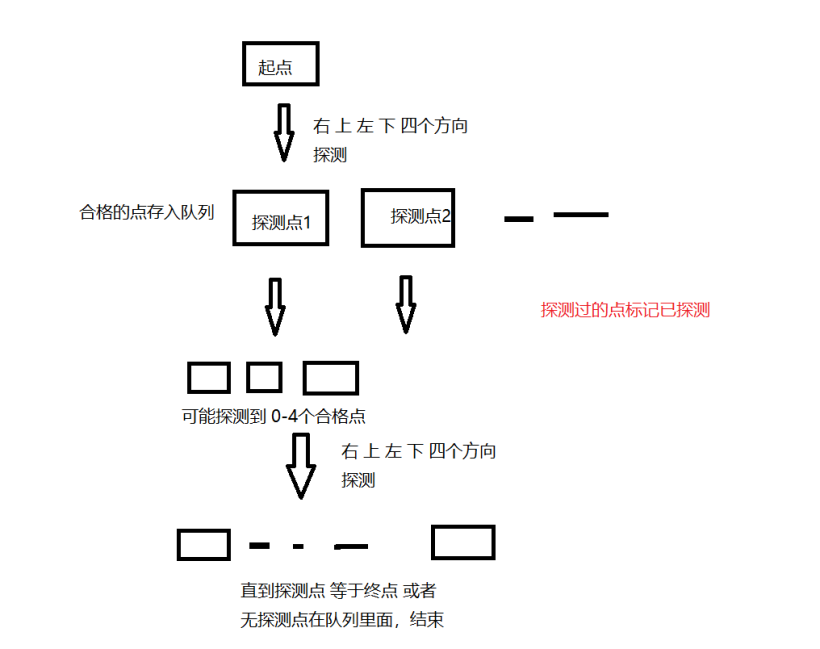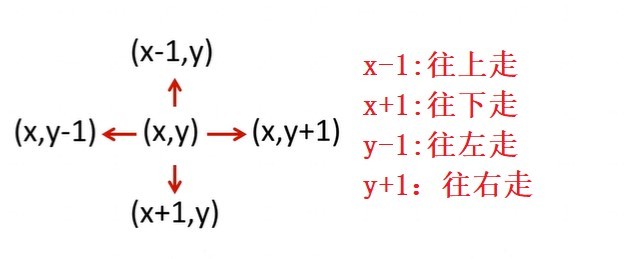openharmony 军棋工兵寻径算法的实现
一,引言
工兵可在铁路线上任意行走,其它棋子在铁路线上只能直走或 经过弧形线,不能转直角弯; 工兵在普通路线上跟其他棋子一样,走一格。但是在轨道上,就 如入无人之地了。可以在轨道上自由移动,怎样走都行,只要不超过 轨道的区域,想走多远就走多远,但是如果有个棋子(不论敌我)堵住路 线,你就不能按照那个路线行进;同时我们还要寻找到最近的路径。

二,算法分析
大体要求
1,工兵从起点到终点过程中不能有障碍物阻挡
2,如何寻求到路径最短?且是否用时最快
3,也有可能起点到终点是死路
军旗的工兵走法特别像迷宫走法;
迷宫算法
1,深度优先搜索(DFS)
它和递归的探测思路是基本一致的,可以看成是递归方式的非递归版本;
2,广度优先搜索(BFS)
广度优先搜索法利用队列的特点,一层层向外扩展查找可走的方块,直到找到出口为止,最先找到的这个答案就必然是最短的。
3,根据特点我们希望最先找到最短的距离故采用bfs的方式;
- 采用队列来记录探测点;当前探测点的四个方向,可以通过的点,保存到这个队列中,并移除当前探测点
 右 下 左 上 的 四个方向探测
右 下 左 上 的 四个方向探测

-
采用一个二维数组来存储 x,y上的障碍物,和探测的点
let noChessBoard: number[][] = [ // a[j][h]代表j行h列数据 // 1,行:row 2、列:column export const ROW = 12 export const COLUMN = 4 [1, 1, 1, 1, 1], [0, 0, 0, 0, 0], [0, 1, 1, 1, 0], [0, 1, 1, 1, 0], [0, 1, 1, 1, 0], [0, 0, 0, 0, 0], [0, 1, 0, 1, 0], [0, 0, 0, 0, 0], [0, 1, 1, 1, 0], [0, 1, 1, 1, 0], [0, 1, 1, 1, 0], [0, 0, 0, 0, 0], [1, 1, 1, 1, 1]]
代码实现
(1)获取到起点和终点坐标
this.routeNode = this.engineerRoute(firstChess, moveChess);
(2)获取二维数组迷宫标记
二维数组是记录棋盘上 0 是表示可通状态,1表示不可通。默认是棋盘铁路都为0可通
然后,敌方和友方其中全部设置为不可通1
// 工兵路径寻找 (bfs 广度优先搜索)
private engineerRoute(start: Chess, end: Chess): RouteNode {
let noChessBoard: number[][] = [ // a[j][h]代表j行h列数据 // 1,行:row 2、列:column export const ROW = 12 export const COLUMN = 4
[1, 1, 1, 1, 1],
[0, 0, 0, 0, 0],
[0, 1, 1, 1, 0],
[0, 1, 1, 1, 0],
[0, 1, 1, 1, 0],
[0, 0, 0, 0, 0],
[0, 1, 0, 1, 0],
[0, 0, 0, 0, 0],
[0, 1, 1, 1, 0],
[0, 1, 1, 1, 0],
[0, 1, 1, 1, 0],
[0, 0, 0, 0, 0],
[1, 1, 1, 1, 1]]
for (let i = 0;i < this.aList.length; i++) {
let a = this.aList[i]
noChessBoard[a.y][a.x] = 1
}
for (let i = 0;i < this.bList.length; i++) {
let b = this.bList[i]
noChessBoard[b.y][b.x] = 1
}
return this.bfs(start, end, noChessBoard)
}
(3)进行广度优先搜索
private bfs(start: Chess, end: Chess, roads: number[][]): RouteNode{
Logger.d(TAG, `bfs roads:${JSON.stringify(roads)}`)
Logger.d(TAG, `bfs start:${JSON.stringify(start)}`)
Logger.d(TAG, `bfs end:${JSON.stringify(end)}`)
let routeQueue = new MyArrayQueue()
let first = new RouteNode(start.x, start.y, 0)
routeQueue.push(first)
while (routeQueue.size() != 0) {
Logger.d(TAG, `bfs scan while routeQueue:${JSON.stringify(routeQueue)}`)
let node = routeQueue.pop()
Logger.d(TAG, `bfs scan pop node:${JSON.stringify(node)}`)
let x = node.x
let y = node.y
if (x === end.x && y === end.y) {
return node
// break
}
for (var i = 0; i < 4; i++) {
let tx = x + this.dx[i]
let ty = y + this.dy[i]
Logger.d(TAG, `bfs scan tx:${tx} ty:${ty}`)
if (tx >= 0 && tx <= COLUMN && ty >= 0 && ty <= ROW && roads[ty][tx] === 0) { // 如果该位置可以走动
// 入队
Logger.d(TAG, `bfs add tx:${tx} ty:${ty}`)
let temp = new RouteNode(tx, ty, node.step + 1)
temp.prev = node
routeQueue.push(temp)
Logger.d(TAG, `bfs scan push :${JSON.stringify(routeQueue)}`)
roads[ty][tx] = 1
}
}
// 扩展完
Logger.d(TAG, `bfs scan one end...`)
}
return null
}
(4)本案例还记录路径,采用的是链表数据结构
每次 把prev给记录下来。这下就可以追溯到整个完整的探测路线
export class RouteNode extends Point {
prev: RouteNode ; //前一个节点
next: RouteNode ; //下一个节点
step: number
constructor(x: number, y: number, step: number) {
super(x, y)
this.step = step
}
}
(5)队列是自己利用数组改成的
openharmony 目前 Deque、Queue 有bug,没法用;只能用数组,然后 数组的pop是最后一个,就把探测顺序插入第一个
export class MyArrayQueue {
nodes: RouteNode[]
constructor() {
this.nodes = new Array
}
push(node: RouteNode) {
Logger.d(TAG, `push ...:${JSON.stringify(node)}`)
this.nodes.unshift(node)
Logger.d(TAG, `push end.:${JSON.stringify(this.nodes.length)}`)
}
pop(): RouteNode{
return this.nodes.pop()
}
size() {
return this.nodes.length
}
}
三,总结
可能代码直接拷贝过去跑不通;
本文也就阐述一种思维,同时体现一下openharmony目的能力可达之处;
本文作者:陈浩南xxx
https://ost.51cto.com/#bkwz
标签:node,openharmony,RouteNode,bfs,TAG,let,寻径,军棋,Logger From: https://blog.51cto.com/harmonyos/5938878